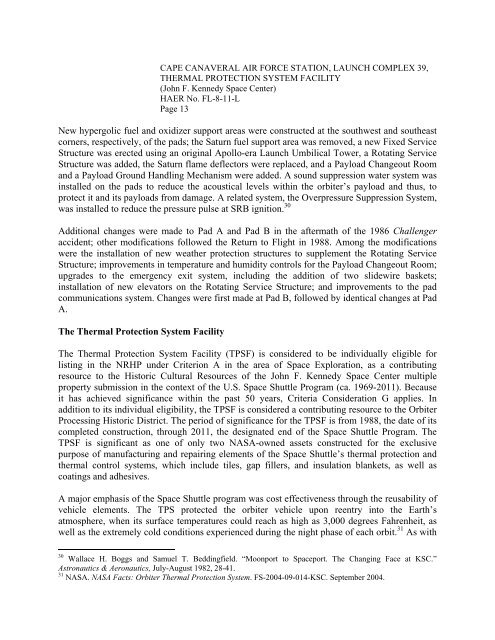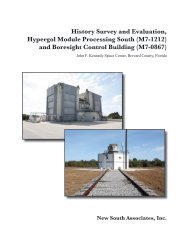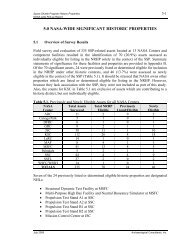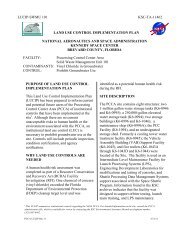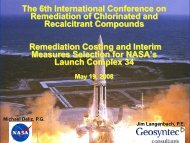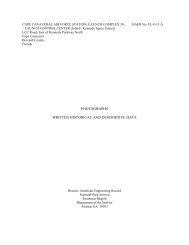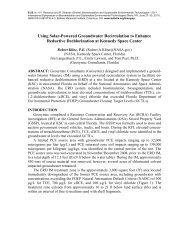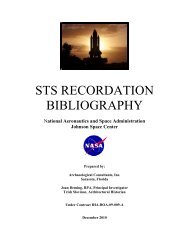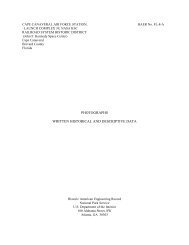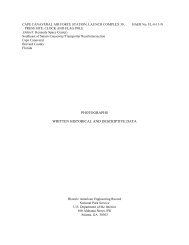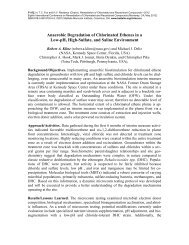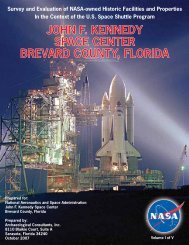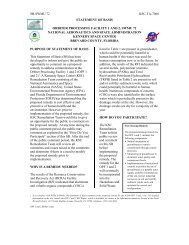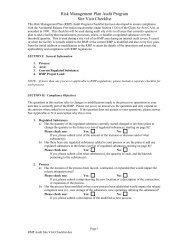Thermal Protection System Facility (TPSF) HAER - Environmental ...
Thermal Protection System Facility (TPSF) HAER - Environmental ...
Thermal Protection System Facility (TPSF) HAER - Environmental ...
Create successful ePaper yourself
Turn your PDF publications into a flip-book with our unique Google optimized e-Paper software.
CAPE CANAVERAL AIR FORCE STATION, LAUNCH COMPLEX 39,<br />
THERMAL PROTECTION SYSTEM FACILITY<br />
(John F. Kennedy Space Center)<br />
<strong>HAER</strong> No. FL-8-11-L<br />
Page 13<br />
New hypergolic fuel and oxidizer support areas were constructed at the southwest and southeast<br />
corners, respectively, of the pads; the Saturn fuel support area was removed, a new Fixed Service<br />
Structure was erected using an original Apollo-era Launch Umbilical Tower, a Rotating Service<br />
Structure was added, the Saturn flame deflectors were replaced, and a Payload Changeout Room<br />
and a Payload Ground Handling Mechanism were added. A sound suppression water system was<br />
installed on the pads to reduce the acoustical levels within the orbiter’s payload and thus, to<br />
protect it and its payloads from damage. A related system, the Overpressure Suppression <strong>System</strong>,<br />
was installed to reduce the pressure pulse at SRB ignition. 30<br />
Additional changes were made to Pad A and Pad B in the aftermath of the 1986 Challenger<br />
accident; other modifications followed the Return to Flight in 1988. Among the modifications<br />
were the installation of new weather protection structures to supplement the Rotating Service<br />
Structure; improvements in temperature and humidity controls for the Payload Changeout Room;<br />
upgrades to the emergency exit system, including the addition of two slidewire baskets;<br />
installation of new elevators on the Rotating Service Structure; and improvements to the pad<br />
communications system. Changes were first made at Pad B, followed by identical changes at Pad<br />
A.<br />
The <strong>Thermal</strong> <strong>Protection</strong> <strong>System</strong> <strong>Facility</strong><br />
The <strong>Thermal</strong> <strong>Protection</strong> <strong>System</strong> <strong>Facility</strong> (<strong>TPSF</strong>) is considered to be individually eligible for<br />
listing in the NRHP under Criterion A in the area of Space Exploration, as a contributing<br />
resource to the Historic Cultural Resources of the John F. Kennedy Space Center multiple<br />
property submission in the context of the U.S. Space Shuttle Program (ca. 1969-2011). Because<br />
it has achieved significance within the past 50 years, Criteria Consideration G applies. In<br />
addition to its individual eligibility, the <strong>TPSF</strong> is considered a contributing resource to the Orbiter<br />
Processing Historic District. The period of significance for the <strong>TPSF</strong> is from 1988, the date of its<br />
completed construction, through 2011, the designated end of the Space Shuttle Program. The<br />
<strong>TPSF</strong> is significant as one of only two NASA-owned assets constructed for the exclusive<br />
purpose of manufacturing and repairing elements of the Space Shuttle’s thermal protection and<br />
thermal control systems, which include tiles, gap fillers, and insulation blankets, as well as<br />
coatings and adhesives.<br />
A major emphasis of the Space Shuttle program was cost effectiveness through the reusability of<br />
vehicle elements. The TPS protected the orbiter vehicle upon reentry into the Earth’s<br />
atmosphere, when its surface temperatures could reach as high as 3,000 degrees Fahrenheit, as<br />
well as the extremely cold conditions experienced during the night phase of each orbit. 31 As with<br />
30 Wallace H. Boggs and Samuel T. Beddingfield. “Moonport to Spaceport. The Changing Face at KSC.”<br />
Astronautics & Aeronautics, July-August 1982, 28-41.<br />
31 NASA. NASA Facts: Orbiter <strong>Thermal</strong> <strong>Protection</strong> <strong>System</strong>. FS-2004-09-014-KSC. September 2004.


